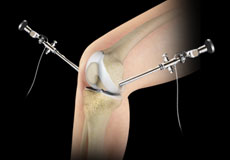What is Arthroscopic Surgery?

Arthroscopic surgery, also known as arthroscopy, is a surgical procedure to visualize, diagnose, and treat problems inside a joint using a specialized instrument known as an arthroscope.
An arthroscope is a flexible fiberoptic tube that contains a small lens or camera and a lighting system to magnify and illuminate structures inside a joint. The camera attached to the arthroscope shows an image of the joint on a television screen allowing the surgeon to examine the affected joint or areas such as cartilage, ligaments, and tendons, and perform the repair.
Different Types of Arthroscopic Surgery
Arthroscopic surgery can be performed on any joint. Shoulder and knee arthroscopy are the most common arthroscopic procedures conducted for repairing meniscus and cartilage problems and fixing rotator cuff tears respectively. Some of the common types of arthroscopic surgery include:
- Shoulder arthroscopy
- Knee arthroscopy
- Ankle arthroscopy
- Hip arthroscopy
- Wrist arthroscopy
- Elbow arthroscopy
Indications for Arthroscopic Surgery
In general, arthroscopic surgery is conducted to diagnose and treat a variety of conditions. Arthroscopic surgery is commonly indicated for:
- Articular cartilage defects and injuries
- Joint debridement and washout for osteoarthritis
- Removal of loose bodies
- Synovectomy
- Meniscal tears
- Anterior cruciate ligament (ACL) tears
- Posterior cruciate ligament (PCL) tears
- Arthroscopic-assisted fixation of tibial plateau fractures
- Evaluation of joints prior to joint replacement
Preparation for Arthroscopic Surgery
Arthroscopic surgery preparation depends on the joint being examined or repaired by your surgeon. However, in general, you are required to:
- Avoid taking certain medications or supplements that may increase the risk of bleeding
- Inform your doctor if you are allergic to any medications or anesthesia
- Avoid consuming liquids or solid foods 6 to 8 hours before surgery
- Wear comfortable clothing to get on and off easily
- Bring assistive devices, such as a walker, cane, or crutches
- Arrange for a ride as you will not be able to drive back yourself
Arthroscopic Surgery Procedure
The surgery is performed under general or local anesthesia. After adequately sterilizing the surgical area, your surgeon makes a few small keyhole incisions through which the arthroscope and tiny specialized instruments are inserted. The joints are irrigated with water to clear debris and aid in visibility. The camera attached to the tip of the arthroscope allows the doctor to view the structures inside the joint through a television screen, and the damaged structures are repaired. The instruments and arthroscope are then withdrawn, and the surgical incisions are closed with sterile dressings or sutures.
Postoperative Care of Arthroscopic Surgery
Before being discharged, your doctor or nurse will give you appropriate postop instructions, such as:
- How to care your incisions and dressing
- Exercises you should do
- What activities you must avoid
- Use of assistive devices like a sling, splint, or crutches
- Use of pain medications
- Rehabilitation program for a quicker recovery
- Follow-up visit to remove dressings or sutures and monitor your overall progress
Risks and Complications of Arthroscopic Surgery
The risks and complications of an arthroscopic procedure are minimal and occur in less than one percent of all arthroscopic surgeries. Some of the possible risks and complications of arthroscopic surgery include:
- Infection
- Swelling or bleeding
- Blood clots
- Damage to nerves or blood vessels
- Instrument breakage
- Anesthetic problems
Benefits of Arthroscopic Surgery Over Traditional Open Surgery
Some of the benefits of arthroscopic surgery over traditional open surgery include:
- Can usually be carried out as an outpatient procedure
- Swelling is substantially reduced due to minimal incisions
- Pain is substantially reduced due to minimal manipulation of healthy tissue
- Risk of infection is less due to the minimally invasive approach
- Risk of complications associated with blood loss is notably minimal
- Shorter hospital stay and much lesser recovery time
- Very minimal incisional scarring
- Reduced surgical risk as arthroscopic surgery is a minimally invasive procedure
- Usually more successful than open joint procedures
- Both diagnosis and surgery can be carried out in one approach
- Use of tiny instruments in arthroscopy aids in minimal damage to surrounding tissues compared to large-sized surgical devices

Knee Arthroscopy
Knee arthroscopy is a common surgical procedure performed using an arthroscope, a viewing instrument, to diagnose or treat a knee problem. It is a relatively safe procedure and you will usually be discharged from the hospital on the same day of surgery.

Ankle Arthroscopy
Ankle arthroscopy is a minimally invasive surgical procedure in which an arthroscope, a small, soft, flexible tube with a light and video camera at the end, is inserted into the ankle joint to evaluate and treat a variety of conditions. The camera projects an image of the inside of the joint onto a large monitor, allowing your surgeon to look for any damage, assess the type of injury and repair the problem.










